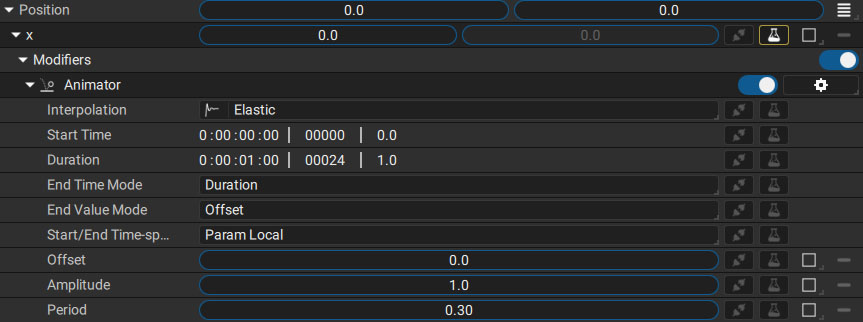Animator: an alternative to keyframe animation
The Animator is a bit special because it is halfway between a Generator and a Modifier. As every Modifier, it can be added to the data embedded in the parameter or on the result of a Generator, but it has two options:
- The value(s) produced can be added to the existing one(s)
- This/these value(s) can progressively replace the existing one(s)
The Animator allows you to generate a 100% procedural animation on a single parameter (1D/2D/3D/4D), defined by a type of evolution, a start time, and a duration or end time.

Depending on the type of interpolation used, additional options, shown here in purple, will be added to the list:
- Amplitude
- Period
- Overshoot
In order to understand the principle of each option, we will start with a simple case: a layer using a Circle generator, with its Position parameter in Separated mode. Position X will be the only one to be animated and an Animator will be added onto it.

Interpolation type
The first parameter defines the type of interpolation between the starting value prior to applying the Animator Modifier and the final value after it has been applied. By default, the Elastic interpolation type is activated, from the 50 available.
Depending on the chosen interpolation type, the parameters Amplitude, Period, and Overshoot will appear, allowing you to control the evolution of the parameter more precisely.
Timing parameters
The animation speed, its beginning, and its end are determined by the following five parameters:
- Start/End Time-space: defines whether the time information is based on:
- the Local time of the layer, taking into account its possible temporal modifications (Time Offset, Speed multiplier, etc.)
- the absolute Composition time, ignoring layer time tweaking
- End value mode: sets how you define the end of the animation. Using a Duration or Custom end Timecode. This will change the name of the Duration parameter to End Time
- Start Time: Time parameter which describes the starting time of the animation, depending of the Start/End Time-space current state.
- Duration/End Time: Time parameter which describes the Duration or End time of the animation
- End Value Mode: setting this to Offset will add the animation relative to the initial value, while Target will progressively replace it by the value set in Offset/EndValue
- Offset/EndValue: value used to offset or replace the original value